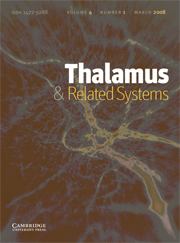Article contents
Differentiation of corticothalamic and collateral thalamocortical synapses on mouse reticular nucleus neurons by EPSC amplitude and AMPA receptor subunit composition
Published online by Cambridge University Press: 12 April 2006
Abstract
AMPA receptors mediate fast synaptic transmission at collateral synapses of corticothalamic and thalamocortical axons in the thalamic reticular nucleus (RTN). These synapses are important in generating synchrony in the thalamocortical network. Whole cell recording in the mouse thalamocortical slice preparation was combined with high-resolution immunoelectron microscopy to characterize AMPA-mediated conductances at the two synapses and to correlate these with differential expression of GluR3 and GluR4 subunits. Thalamocortical collateral (TC) synapses had larger mean EPSC amplitudes (1914 ± 1814pS) than corticothalamic (CT) synapses (400 ± 257 pS), and rise and decay times of TC EPSCs were faster and less variable than CT EPSCs, probably reflecting proximal and dispersed locations of TC and CT terminals, respectively, on RTN cells. In situ hybridization and immunocytochemical studies revealed that GluRl and GluR2 subunits are not expressed in the RTN and GluR4 subunits are expressed at higher levels than GluR3 subunits. Immunoelectron microscopy revealed gold particles representing GluR3 or GluR4 subunits concentrated at single postsynaptic densities (PSD) characteristic of CT synapses and at the two to seven split PSD segments characteristic of TC synapses. At CT synapses the number and density of GluR4 particles were 2.5 times greater than GluR3 particles. At the larger TC synapses, the number of GluR3 particles exceeded that of GluR4 particles but density of GluR4 particles was lower than at CT synapses while density of GluR3 particles was similar. Despite enrichment of GluR4 subunits at CT synapses, larger conductances prevailed at thalamocortical collateral synapses, probably reflecting both larger overall numbers of AMPA receptors and a greater number of release sites represented by the split PSDs. Variability in amplitudes of TC EPSCs may reflect variability in the number of release sites; lower variability in CT EPSC amplitudes may reflect a more constant number of release sites.
Keywords
Information
- Type
- Research Article
- Information
- Copyright
- 2001 Elsevier Science Ltd
- 12
- Cited by

